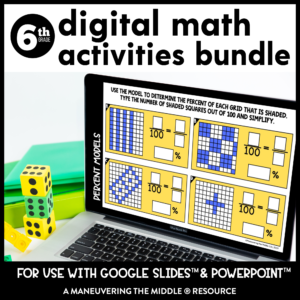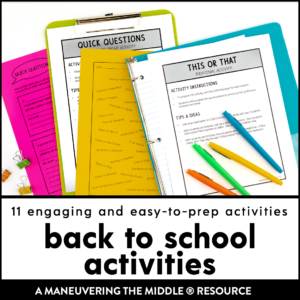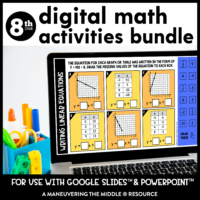Are you a nomadic teacher? No single classroom to call your own, but instead, you travel from classroom to classroom teaching from a cart?

TIPS for Teaching FROM A CART
The idea is simple. Instead of rotating hundreds of students, rotate the teachers. This makes sense from a logistical standpoint, but it does add 16 more things for teachers to think about on a daily basis. (Did you know a teacher makes more decisions than a brain surgeon in a single day?) Or perhaps, lack of classrooms mean some teachers have to use classrooms that were previously empty during a planning period?
So let’s figure this one out together, teacher friends. How are we going to run a middle school math class from a cart?
Which cart is best?
I think the cart you choose says a lot about the class you run. Do you use technology and need to be able to plug in easily when you get to a new room? Will your cart be moving from one room to another next door, or will you be running across the school – possibly outside and over curbs or need to fit in and out of an elevator? Will you have some kind of home base in the classrooms you are traveling to, so not every single item has to be on your cart? Or will you literally only have your cart for the entire school day?
After searching and reading reviews for the top recommended carts, I found my top picks. My top criteria involved something that can be pushed or pulled without hunching over because if you are teaching from a cart, you are going to need to be comfortable.
*Note: The teal cart (from Ikea) that I used for the above photograph is not a cart recommendation from me. It is too short to push around comfortably and is too small to fit necessities.*

OPTION #1 – $149.98
Pros
- Large wheels
- Push handle
- Plastic/Sturdy
- 2 shelves
Cons
- Lip on top would make it challenging to work on your laptop from the top shelf would need to raise it up some way
- Lack of storage space
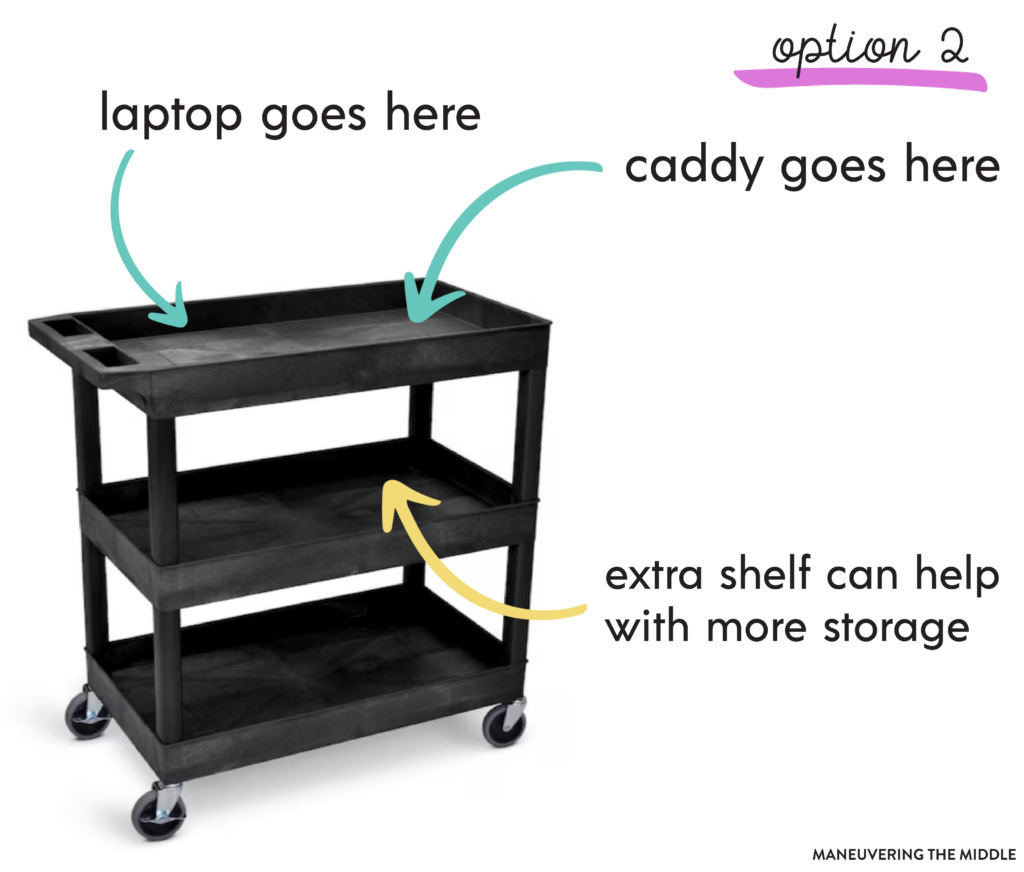
OPTION #2 – $159.00
Pros
- Large wheels
- Push handle
- 3 shelves
Cons
- Lip on top would make it challenging to work on your laptop from the top shelf would need to raise it up some way
- Shelves are not adjustable
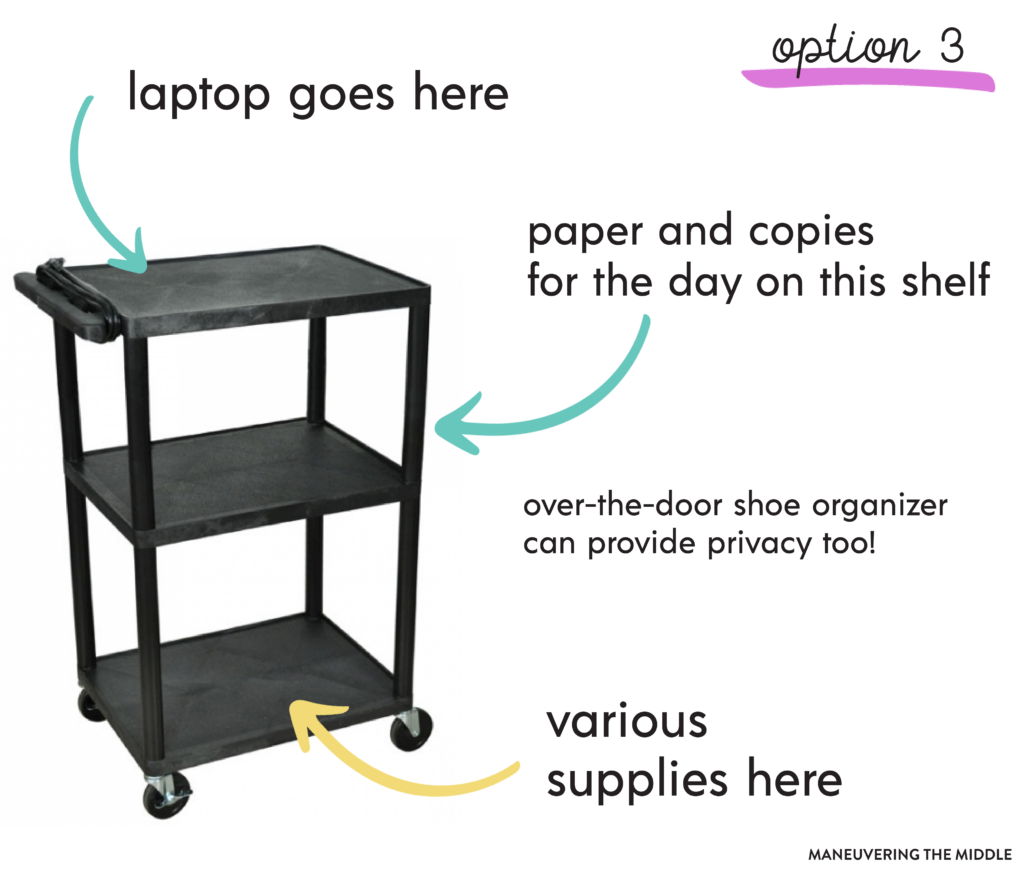
OPTION #3 in 42″ – $120.95 Available in 36″
Pros
- Attached power strip so you just have to plug in the cart
- 3 shelves
- Locking wheels
- There are many other varieties; see more here.
- I used this cart in my classroom for 4 years, and I can vouch for its quality.
Cons
- No lip on the top, so maybe items could slip off.

OPTION #4 – $199.95
Pros
- Locking cabinet
- Attached power strip
- 2 shelves
Cons
- Pretty expensive

OPTION #5 – $46.57
Pros
- Inexpensive
- Sturdy
- Better than carrying around a milk crate
- Easier to travel around school
Cons
- You will have to pack/unpack your computer between classes

OPTION #6 – $89.96
Unfortunately, I don’t think the perfect cart exists. However, I think teachers will find a cart and perfect it through their creativity and ingenuity.
I would take advantage of velcro strips to keep supplies secure or from tipping over.
What do I need?
Now that you have your cart, let’s fill it up! But which supplies are most essential for making their way on your cart? I recommend thinking through what happens in a class period — what are you reaching for? What is a student missing that you are typically supplying? Things like a stapler or tape might be something that would live on top of your teacher desk, but if you aren’t using those items actively during a class, they might not make the cut. If you are my favorite coworker, Leah, you will probably find a way to fit a Keurig on yours. You do you!
Here is what would go on my cart (check out my favorite supplies here):
- Top Shelf – Laptop, clicker, charger, any cables to connect to doc cam or projector, possibly a doc cam if classrooms aren’t already outfitted with them.
- Middle Shelf – My pink supply caddy (similar here) filled with binder clips, band aids, stickers, etc. My pen caddy filled with highlighters, Mr. Sketch markers, pens, and pencils. A small file folder box or accordion folder for any scratch paper or handouts.
- Bottom Shelf – Clorox wipes, hand sanitizer, and empty space for anything else that might come up. And my purse/wallet in some kind of secured or hidden space. Most likely, I would stuff those items in a milk crate and cover it with a cardigan. Oh yeah, a cardigan because you know all the different classrooms will be freezing.
- Sides – I would utilize the sides of my cart with some hooks. This could help wrangle cords. Adding a shoe organizer (using zip ties) to the side could give you so many pockets!
When I chatted with teachers about making a cart work, we all came to the unanimous decision that going as digital as possible would alleviate many of the space issues that come with having a cart. If students receive and turn in most of their assignments online, then you will not be carting around hundreds (thousands) of pieces of paper.
Leaving Class Checklist
Teaching from a cart will require a leaving class checklist. The leaving class checklist would be a mental, digital, or physical list you are responsible for going through before leaving a classroom to move to another classroom. This isn’t just for your sanity, but for the sanity of other teachers about to use the room. Perhaps, you could create a Google Doc and ask your colleagues to contribute to the list to prevent any future discord. Here are a few questions I brainstormed:
- Did I gather all of my materials?
- Did I leave communal items in an easy to find place (projector remotes, hall pass, etc)?
- Did I hold students accountable to cleaning up after themselves?
Shared Spaces
Agree on a designated space in each classroom where you can keep some of your things. This is important for two reasons: physical environment and extra materials. In my classroom, I pointed to my word wall or anchor chart everyday. It is important for content, but I believe that if a student is going to be in the same classroom for most of the day, it should look loved and cared for. I think extra supplies are inevitable and should be planned for. As a math teacher, I would want a few choice manipulatives, calculators, and pencils at my disposal no matter where I am.
Be Mindful
Do a run through before the first day of school. Wheel your cart to each room you will be traveling to. Make sure your cart can handle turns and that none of your supplies topple over. In each classroom, plug in your computer and make sure you can connect to the projector in a few moments. Tip: I think connecting technology can be a huge time waster for teachers, so make sure students have started working on a bell ringer before you spend time connecting cables.
Teachers, any other ideas out there? Teaching from a cart will not be easy, but if I know anything about teachers, it’s that they are resilient and CAN DO ANYTHING.


